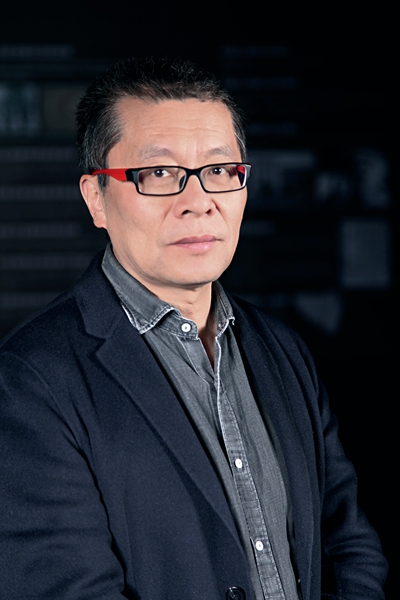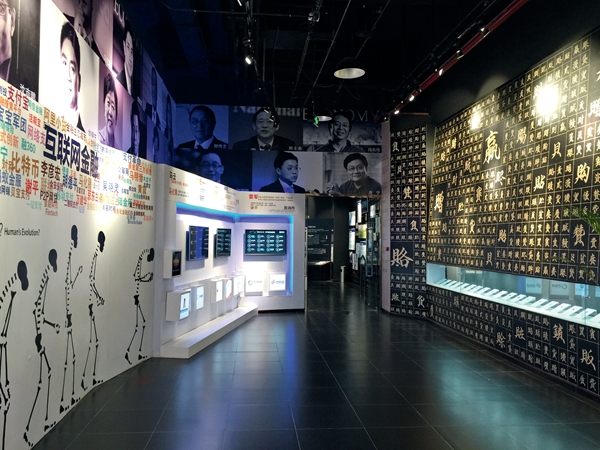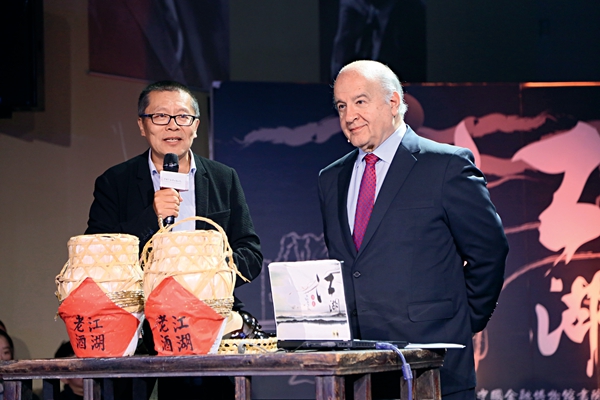By LIU DONG
By LIU DONG
CHAOYANG Park, adjacent to Beijing’s East Fourth Ring Road, is the site of a staid red-brick building that emanates a civic ambience. After entering and walking through a coffee shop I came to a well-lit conference room, on whose wall hung the Chinese calligraphic inscription confirming that this establishment was indeed the Museum of Global Finance. It was here that I met with the museum’s chairman, Wang Wei.

I began our interview with the question, “How did you come to combine China’s contemporary financial trends with the traditional, old-school concept of a museum?”
Wang Wei answered, “We did not do it out of thin air, but instead responded to the social need. It’s a result of our team’s exploration. I wanted to build a platform on which to explain contemporary financial concepts to the general public and illuminate the impact they have on daily life, but under the elegant and convivial backdrop of a museum.”
A Self-taught Expert
In the summer of 2008, many financial specialists began scanning history for inspiration in the wake of the global subprime crisis. There were reports in foreign media of a substantial uptick of visitors to the Museum of American Finance on Wall Street. Wang Wei was among the many whose curiosity was whetted by the crisis. Shortly after, in the company of the then vice mayor of Tianjin, Cui Jindu, he paid a visit to the museum. Both men drew great inspiration from their one-hour visit. Compared with its European peers, the U.S. financial industry has a short history. But vivid images created through the museum’s advanced acoustic photoelectric technology enabled visitors to gain a rapid understanding of the history of the industry and how the crisis came about.
Upon their return, Wang Wei and Cui Jindu both realized that China needed such a museum, and immediately set about establishing one. Cui’s task was to find a suitable place; Wang’s to engage financial expertise. Cui quickly achieved his goal, but Wang’s was less straightforward. A museum of finance is a cross-border concept, totally unknown to contemporary financers. There is also a dearth of museum curators specializing in finance.

Seeing no other alternative, Wang decided to do it himself. “I forced myself to undergo training and become a qualified expert in the crossover field.” A financial background by virtue of more than 20 years’ experience in the industry, notably as a specialist in merger and acquisitions, gave wings to Wang’s interest in the museum. Before long he had acquired a systematic understanding of finance and its history, economic history, and the history of economic thought. After reading classic Chinese works on financial history and related writings in English and Japanese, and applying his practical experience to what he had learned, Wang gradually gained new insights and a clear picture of the realm of finance. He also traveled extensively in search of finance-related exhibits for the museum.
On June 9, 2010, the Chinese Museum of Finance, China’s first privately owned museum to focus on the finance industry, officially opened its doors. It is located on the site of the former French Club, a century-old European building, in Tianjin. Exhibits in the 2,400 sq.m. main hall included handwritten manuscripts by acknowledged father and founder of contemporary economics Adam Smith, Thomas Edison’s first light bulb, documents relating to the establishment of the Shanghai Stock Exchange, including directives from former premier Zhu Rongji, bonus stocks from the “cultural revolution” period, over 200 currencies from various historical epochs in China and overseas, financial bills, and financial artifacts. Apart from donations from friends and associates in financial circles, the bulk of these exhibits were personally purchased by Wang on his global forays to stock the museum.
Many distinguished guests were present at the museum’s opening ceremony, and well-known Chinese economists Wu Xiaoling and Zhang Weiying were invited as its consultants. Former director of the Museum of American Finance Alan Lee Kjelleren also made a special trip to attend the ceremony.
The success of this venture inspired Wang to carry on in this vein. He has since built five more financial museums – in Tianjin, Suzhou, Beijing, Shanghai, and Shenyang – all within the past decade.
From “Black Sheep Financier” to “Father of Financial Literacy”
Looking back on the past decades, Wang himself is more surprised than anyone that his career has branched out to the enshrining and explaining of finance.
Born in 1958, Wang was among the first group of college students who had taken the reinstated college entrance examination after the “cultural revolution.” He was enrolled by Dongbei University of Finance and Economics (DUFE) and studied accounting. The university has been regarded as the illustrious Whampoa Military Academy of the Chinese financial sector. However few people at that time were familiar with the concept of “finance.”

In 1982, one year after his graduation, Wang entered the Graduate School of the People’s Bank of China in Beijing, and later worked for China Construction Bank and Bank of China. Owing to the scarcity of financial talents, the young and promising Wang stood out and was highly valued. But he had his own plans, having decided to broaden his horizons and enrich his experience by going abroad. He held a much envied post, and the bank’s leaders also tried to dissuade him. But Wang opted not to play by the rules, and took unpaid leave to study in the U.S.
While studying abroad, Wang took successive internships and work-study programs at Citibank, JP Morgan Chase, and the World Bank. He had frequent discussions with excellent overseas Chinese financial talents about the trend of Chinese economic development. After returning to China in 1992, Wang took a hand in the establishment of Southern Securities, and was later promoted to vice president. However, he chose to resign again and started his own business at the point when China’s stock market was at its peak.
In May 1997, Wang set up the M&A Group which specialized in enterprise mergers and reorganization, and the corresponding financing and listing. But he was not content with simply going into business, and then set out to establish the China Mergers & Acquisitions Association with himself as the founding chairman, and at the same time published his works including Second Board Market and MBO: Management Buy-out. These books are considered classics, and widely influential in the financial investment sector. Wang also taught at the Cheung Kong Graduate School of Business, where he called for formulating financial industry norms, so winning the epithet “Father of Merger and Acquisition in China.” Wang also earned himself the reputation among insiders as a “black sheep financier” due to his unconventional experience.
When asked, “Why increase your financial and mental input in such a low-return business as a museum?”
Wang replied, “I’m an intellectual as well as a businessman. A person can’t spend their entire life pursuing fame and wealth. Everyone has his own interests and passion which take no account of the returns they generate. Some may assume that I am aiming for greater fortunes in the future even though I’m not making profit at present. I feel neither the will nor the need to explain. I just laugh it off.”
So it was for the sake of personal satisfaction that Wang began establishing museums; because it amused him, he said. “We have many adventures in our life and time is limited. I am lucky enough to have the means to pursue what I love.”
Wang believes the museum has a positive social impact, but it signifies more than that to him. “By founding museums I have learned many knowledge that meant nothing to me before. These six museums are to me like six bachelor degrees that I have gained through finance-related majors. I could not be more satisfied with the result.”
“If, in a few years’ time, among the students who have undergone financial literacy education on the platform of our museum, someone stands out in the business world as excellent as Jack Ma, or wins a Nobel Prize, I will be proud enough to shed tears.”
Wang believes there are tens of thousands of financial entrepreneurs like him in China; however, few are likely to establish a financial literacy program like the one the museum offers. Wang has consequently come to the conclusion, “I believe I have my own value and special meaning to the industry, which is also a matter of great pride.” He is determined to stick to his guns in order to make known that financiers can also be intellectuals, of which he is living proof.
Museums as an Exchange Platform
Since the founding of the Chinese Museum of Finance, Wang has envisioned the museum’s role as focusing on financial literacy and exchanges rather than collecting exhibits. Shortly after the opening, Wang invited dozens of high school volunteers to visit the museum and raise suggestions about anything that was not clear to them. Wang believes that a museum is lacking something if a high school student can’t comprehend its content and function. Since then, he has launched five more museums and operated them according to this idea. All have been wildly acclaimed, as manifested in their growing numbers of visitors.
Apart from taking charge of daily exhibitions, Wang has continuously innovated the museum’s particular brand of cultural exchange. Together with other entrepreneurs, he co-founded the Financial Museum Academy and formed regular reading groups under the theme “Enriching Life through Reading.” Special guests included carefully selected entrepreneurs and economists whose rich experience and life wisdom benefited other participants. With Wang as the witty and humorous host, these reading sessions became so popular that each one was a sell-out. Later, Wang regularly held “Legend Salons” in the Museum of Global Finance in Beijing, and invited celebrities and renowned men of letters from China and abroad to give speeches and share their stories. These salons share the same popularity as the reading sessions.
“Sharing life experience and wisdom through great vision and prospects can enlighten society and inspire the public. We feel compelled and challenged as well as interested in conducting these exchanges,” Wang said.
Wang also considers financial literacy as seperate from traditional education. The former attaches more importance to participants’ learning, sharing, and innovation. Its focus is on liberating financial knowledge from a few professionals and certain financial giants and sharing with budding entrepreneurs, consumers, and the public. People may then understand that an excellent financial system can make us happier, safer and more independent.
Over the past few years, Wang, with the help of his six financial museums, has carried on his resolve to spread financial literacy. The museums have held nearly 100 “Reading Parties,” “Legend Salons,” “Lessons on Leading Financial Topics,” “Afternoon Tea at the Museum” and “Financial Story Meetings.” In 2015, they invited 40 directors of financial museums in 12 countries to the announcement of the “Beijing Financial Literacy Manifesto,” and officially set up the “China Center of Financial Literacy,” which has been in operation for four years. Participants are committed to universally improving financial literacy. During the conference they established all sorts of forums, dialogues, and financial salons. Wang Wei’s research results have been captured in a book titled The Subversive Power of Finance in History which was a financial literacy bestseller.
In the process of promoting public financial literacy, Wang and his team have also constantly improved themselves. Throughout the successive establishments of the first Chinese Museum of Finance in Tianjin in June, 2010; the Museum of Funds in Suzhou in 2011; the Museum of Global Finance in Beijing in 2012; the Museum of Fintech in Beijing in 2015; the Museum of Mergers and Acquisitions in Shanghai the same year; and the Museum of Industrial Finance in Shenyang one year later, they have constantly upgraded their understandings of each museum’s function and role as an educational exchange platform.
The main exhibits of the first Chinese Museum of Finance still comprise various currencies in China and abroad from different historical epochs, financial bills, and financial objects. The accent of the world’s first Museum of Fintech located inside the Fintech Industrial Park in Haidian District, Beijing, is digital. As a high-end financial community, the museum presents, through various activities and events, the cutting-edge information revolution and evolution of Fintech. After visiting the museum, I became aware of certain new financial concepts like Bitcoins and the blockchain, knowledge that made me feel like a finance freshman.
Many Fintech (Museum) talks, held at the hall of the Museum of Fintech, have received positive feedback. The various learning and communication activities conducted in the museum have become accepted facets of it, and a popular medium through which financiers may disseminate new ideas and concepts to people from all walks of life.
LIU DONG is a veteran reporter.